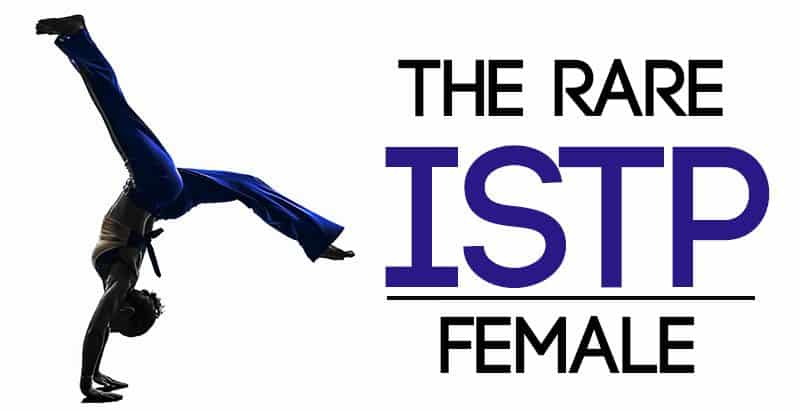“Both in fighting and in everyday life you should be determined though calm. Meet the situation without tenseness yet not recklessly, your spirit settled yet unbiased. Even when your spirit is calm do not let your body relax, and when your body is relaxed do not let your spirit slacken. Do not let your spirit be influenced by your body, or your body be influenced by your spirit.”
Miyamoto Musashi – ISTP
The ISTP Personality Type
Curious if you’re an ISTP personality type? You’re in the right place. We’re going to break down what makes ISTPs tick, what their cognitive functions are, and even look at some famous people with this personality type. ISTPs, or “Vigilantes” as I like to call them, are known for their quiet intensity, their fearlessness, and their ability to think quickly in a crisis.

Their dominant function, Introverted Thinking (Ti), makes them natural-born problem solvers, constantly analyzing, dismantling, and refining their understanding of how things work. This isn’t just theoretical, either—ISTPs have an uncanny knack for breaking things apart (sometimes literally) and putting them back together better than before. If there’s a crisis, they’re the ones calmly figuring out a fix while everyone else is running around in panic mode. Their Sensing side (Se) makes them hyper-aware of their surroundings, letting them react with lightning speed and a realistic, unbiased perspective.
You’ll find plenty of ISTPs throughout history and pop culture—people like Miyamoto Musashi, the legendary samurai strategist; Ron Paul, the no-nonsense congressman; Clint Eastwood, the ultimate “speak softly and carry a big gun” cowboy; and Scarlett Johansson, who plays a literal spy way too convincingly. Whether they’re wielding a sword, a scalpel, or just a well-timed sarcastic remark, ISTPs move through life with a mix of quiet intensity and effortless competence—just don’t expect them to explain what they’re thinking while they do it.
What Does ISTP Stand For?
I = Introversion. ISTPs focus inwards before outwards, analyzing what things mean to them before responding to the environment.
S = Sensation ISTPs focus on the real world and facts and evidence before focusing on concepts and abstract ideas.
T = Thinking. ISTPs analyze things logically before they focus on their values or the feelings of others.
P = Perceiving. ISTPs have a flexible, relaxed approach to life rather than having a repetitive structure or formal set of guidelines.
What Are They Like?
ISTPs tend to have a laid-back, relaxed approach to life. They need a lot of independence and crave freedom to act whenever they feel like it. Constraints, rules, and micro-management are sure to stress then out and frustrate them. Like most Sensing-Perceivers, ISTPs like to feel like they can pick up and go wherever they want and whenever they want. They also want to take action when the timing hits them as “right.” That said, ISTPs also like having their own plan and often have ideas and visions about where they want to go with life. While they may not verbalize these ideas very often, the thoughts do swim around in their mind on regularly.
When it comes to communication, ISTPs tend to be direct and casual. They don’t like pretentiousness and tend to get annoyed with people who seem to be putting on an act or using grandiose words just to make an impression. ISTPs are likely to get to the point quickly and with as few words as possible rather than beating around the bush. In fact, they hate rambling. There’s almost nothing worse for an ISTP than being stuck in a conversation with someone who’s droning on and on about minutiae. If something can be said in 15 words instead of 500, the ISTP will probably use 10. But just because ISTPs are direct and concise doesn’t mean they’re heartless. ISTPs care about others and do want to have positive interactions with people. They may not always feel certain about how to do so, but they enjoy people who can laugh with them, join them for adventures, and trade knowledge together.
ISTP Motivations and Weaknesses:
Stressors: Lack of alone time, micro-management, chaotic emotional atmospheres, feeling controlled.
Driving Force: To understand how the world and everything in it works and fits together in a logical way. To have mental clarity and cohesion.
Backup Strength: Strong attention to detail and ability to think quickly in a crisis. They pay attention to what’s going on around them and often know how to maximize the moment or use resources to find solutions.
Weaknesses: May be so focused on understanding objects and systems that they lose touch with the human relationships they also crave. May struggle to pick up on emotional cues or validate others’ feelings. They may feel uncomfortable in highly emotional settings or around people who expect a lot of rapport or feedback.
ISTP Personality Traits:
While everyone varies based on their background and Enneagram type, most average to healthy ISTPs have the following characteristics:
- They usually recall data quickly and accurately.
- They are skilled at weighing the pros and cons and finding leverage points in a decision.
- They yearn for accuracy and logical consistency.
- They have a knack for figuring out how things work.
- They quickly grasp the underlying principles of a problem or idea.
- They are realistic and down-to-earth
- They need a great deal of alone time.
- They highly value autonomy and independence.
- They dislike a lot of rules or guidelines.
- They may inadvertently be tactless, without meaning to cause emotional harm.
- They respond quickly in crisis situations.
ISTP Careers:
Which career is best for an ISTP? While common careers include software developers, mechanics, pilots, and paramedics, there are many other options as well. The key is for the ISTP to have autonomy, challenge, and hands-on action. They want to see an immediate outcome to what they’re doing and have the opportunity to reach goals in their own way. As hands-on realists, they enjoy fixing things and finding tangible resources to create unexpected solutions.
ISTPs also need some variety in their careers. Being able to move around and get outdoors is a huge bonus! Sitting at a desk from 9-5 drains them and they’ll probably find themselves dreaming of greener pastures if they’re stuck in a repetitive job, caged in by cubicle walls. Competitions, prizes, and opportunities for travel also tend to get them invigorated and focused. Being able to move, respond to situations as they arise, and be flexible is ideal. Independence is also essential. They want to be able to create plans and come up with solutions without having to worry about a lot of micro-management or rules.
Career Suggestions: Race car driver, Missing persons investigator, Software developer, Computer programmer, Geologist, Paramedic, Coach, Mechanic, Flight engineer, Audiovisual specialist.
You might also enjoy: 30 Day Personal Growth Challenge for ISTPs
Famous ISTPs:
Miyamoto Musashi, Jack Dorsey, Ron Paul, Magnus Carlsen, Miles Davis, Frank Zappa, Stanley Kubrick, Clint Eastwood, Harrison Ford, Tom Cruise, Christian Bale, Eminem, Scarlett Johansson, Kristen Stewart, Bill Murray, Bruce Lee, Daniel Craig, Anna Kendrick, Simon Cowell
The ISTP’s Cognitive Functions: The Inner Workings of a Quiet Maverick
ISTPs are like the cool loners in action movies. They don’t monologue. They don’t explain their plans. They just do things, usually in a way that makes everyone else look like they’ve been trying to assemble IKEA furniture without a manual. Their secret? A fascinating cognitive stack that keeps them two steps ahead and deeply immersed in figuring out how things work.
Dominant Function: Introverted Thinking (Ti) – The Mechanic of the Mind
Let’s talk about Introverted Thinking (Ti), the ISTP’s dominant, or “hero” function. This function doesn’t just enjoy logic—it lives and breathes it. Ti is always categorizing, defining, and breaking things down to their essential principles. It’s like having an internal database where every fact, experience, and observation gets processed, dissected, and organized into a system that makes sense.
Imagine an ISTP staring at a broken appliance. Some people might think, Wow, it’s broken. That’s unfortunate. An ISTP thinks, What is the core principle that makes this thing work? What variables are at play? What happens if I remove this tiny, insignificant screw that actually turns out to be the linchpin of the entire structure?
They’re problem solvers at their core, but not in the “let’s brainstorm in a group and hug it out” way. More in the “leave me alone while I take this apart and put it back together, and don’t interrupt unless you’re bringing me snacks” kind of way. Their ability to isolate variables and get to the truth of a problem is why so many ISTPs excel in hands-on professions—engineering, mechanics, programming, surgery. If it involves precision, systems, and independent thinking, they’re in their element.
Of course, this laser-focus on logic means they sometimes forget that humans are not, in fact, logical creatures. If you tell an ISTP that you’re sad because Mercury is in retrograde and your cat looked at you funny this morning, they’re likely to blink at you and say, “That… doesn’t make sense,” before offering you a practical solution like, “Have you tried getting a new cat?” (They mean well. Really.)
Auxiliary Function: Extraverted Sensing (Se) – Living in the Now
While Ti is inside, working its little gears and making everything make sense, Extraverted Sensing (Se) is the ISTP’s outward-facing function, and it’s all about experiencing the world in real time.
ISTPs are the ones who are doing. If there’s a thrill to be had, a skill to master, or a new hands-on experience to dive into, they’re already there. For some, this means racing motorcycles, experimenting with combat sports, or somehow knowing exactly how to win at any arcade game. For others, it means mastering the perfect way to cook sourdough bread or enjoying the sensation of sand between their toes on the beach. ISTPs have a natural connection to the physical world that makes them absurdly capable at reacting to what’s in front of them.
Extraverted Sensing makes ISTPs adaptable, perceptive, and often freakishly good at anything involving hand-eye coordination. Need someone to thread a needle in record time? Give it to the ISTP. Need someone to catch a falling glass before it shatters? If an ISTP is in the room, the glass will be caught, examined for flaws, and possibly thrown back into the air just for fun.
This function also explains why ISTPs get bored out of their minds when forced to sit still for too long. They crave real-world experience and immediacy. Sitting through a long-winded speech about visionary business strategy for the year 2040? Absolute torture. Give them a real-world problem to solve right now, and they’ll be in their element.
Tertiary Function: Introverted Intuition (Ni) – The Subtle Strategist
ISTPs don’t often get credit for their intuition, but that’s because their Introverted Intuition (Ni) operates quietly in the background like a ninja. It’s not their go-to function, but it’s there, occasionally whispering, Hey, you should probably think about the consequences of this impulsive decision.
For a type that truly lives in the moment, ISTPs can have startlingly accurate hunches about where things are headed. Ni gives them flashes of insight that help them predict obstacles before they happen. It’s why an ISTP who’s deeply experienced in something—whether it’s combat sports, mechanics, or even social interactions—can seem almost psychic in their ability to anticipate what’s coming next.
But here’s the thing: ISTPs trust their hands-on experience far more than gut feelings. So while their Ni might be whispering a warning, they’ll often ignore it unless there’s hard proof to back it up. This is why young ISTPs sometimes find themselves in situations where they think, I probably shouldn’t do this—but then immediately do it anyway. (Hey, at least it makes for a good story.)
Their Ni also shows up in how they appreciate depth in conversation. While they might not be constantly pondering the mysteries of the universe, ISTPs love people who can engage them in unexpected, thought-provoking ways. If you can keep up with their logical mind while also throwing in a few, “But have you considered this weird philosophical angle?” insights, you’ll have their attention.
Inferior Function: Extraverted Feeling (Fe) – The Awkward Social Compass
And now, we come to the ISTP’s Achilles’ heel: Extraverted Feeling (Fe).
Fe is all about emotional harmony, reading the room, and making people feel understood. Unfortunately, this is the function ISTPs feel more uncertain around. Not because they don’t care about people (they do, in their own way), but because emotions are just so… illogical.
ISTPs can sometimes come off as emotionally detached, not because they don’t feel, but because they don’t always know what to do with emotions—either their own or other people’s. If someone is crying in front of them, their first instinct isn’t to offer a hug and soothing words; it’s to fix the problem so the crying stops.
However, Fe does have an impact on ISTPs, even if it’s buried deep. Under stress, they can suddenly experience emotional outbursts that shock everyone, including themselves. One minute, they’re their usual cool, composed selves. The next, they’re yelling about how nobody appreciates them before awkwardly retreating to go dismantle their video game console in silence.
This Fe stress reaction can make ISTPs feel out of control—like they’re drowning in emotions they don’t understand. But as they grow and mature, they start to recognize that emotions do have their own logic, even if it’s a different kind than Ti prefers. They may never be the warmest, most emotionally expressive people in the world, but they can learn to value deep connections and recognize when someone just needs them to listen rather than fix.
Final Thoughts: The ISTP Balancing Act
At their best, ISTPs are logical, capable, and endlessly adaptable. They see the world as one big puzzle to figure out, and nothing excites them more than a challenge worth tackling. They have a way of making logic seem effortless, of reacting to life’s chaos with a cool head and lightning-fast reflexes.
But their journey isn’t just about mastering skills and solving problems. It’s also about learning to trust intuition, to value connection, and to recognize that sometimes, feelings are also data. The more an ISTP embraces all their cognitive functions, the more unstoppable they become—equal parts strategist, problem-solver, and (reluctant) emotional being.
And if you’re lucky enough to know an ISTP? Just remember: if they fix something for you without being asked, that’s their version of “I care.”














